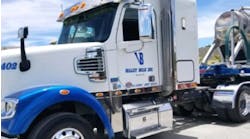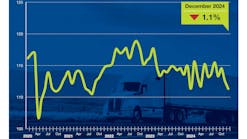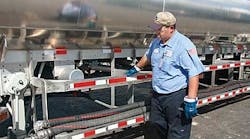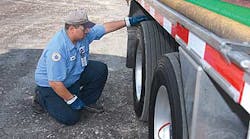DRIVER training and driver inspections are important components of a good cargo tank management program. And, a good cargo tank management program is more important than ever with the Compliance, Safety, Accountability (CSA) safety enforcement program in full force.
A driver who transports hazardous materials in a cargo tank motor vehicle (CTMV) has one of the toughest jobs in the industry today. It's important that drivers are properly trained in regard to the regulations and the trucking company's inspection policies and procedures. Drivers should not only know how to conduct pretrip, en route, and post-trip inspections, but how to properly prepare a vehicle inspection report.
Two federal agencies impact the driver training and driver inspection programs cargo tank companies have in place — theFederal Motor Carrier Safety Administration (FMCSA) and the Pipeline and Hazardous Materials Safety Administration (PHMSA).
FMCSA regulations
The FMCSA, the agency that oversees the operation of all commercial vehicles (not just CTMVs) has several driver inspection requirements when it comes to the vehicle itself. These requirements include:
- Pretrip inspection.
- En route inspections.
- DVIR (referred to by some as the “post-trip inspection”).
Pretrip inspection
Sections 392.7 and 396.13 of the federal regulations state that the driver cannot operate the vehicle until satisfied that it is in good working order. The regulations state that the inspection should include: Service brakes (including trailer brake connections)
- Parking (hand) brake
- Steering mechanism
- Lighting devices and reflectors
- Tires
- Horn
- Windshield wipers
- Rear-vision mirrors
- Coupling devices
- Wheels and rims
- Emergency equipment
However, this is only the minimum requirement. In most cases, drivers need to check much more than what is listed in the regulations to make sure the vehicle is in good working order.
Along with the vehicle pretrip inspection, a tank truck driver must make sure that the product in the tank is secured from leaking or spilling, and that safety equipment in and on the vehicle is adequately secured. These matters are based on Section 392.9. Drivers need to make sure that valves on the tank are closed and that caps and covers are in place. Safety equipment such as cones must be securely strapped to the vehicle. Items in the cab must not obstruct the driver's view or his ability to exit the vehicle or access emergency equipment.
The pretrip inspection requires the driver to check the driver vehicle inspection report (DVIR) submitted by the last driver to operate the vehicle. If the previous driver noted any defects on the DVIR, the driver will have to sign that those defects have been addressed and submit the report to the company.
En route inspections
En route inspections are required of drivers transporting hazardous materials and involve checking the tires on the vehicle when beginning the trip (loading the hazardous materials), each time the vehicle is parked while transporting the material, and at the end of the trip (when unloading). Tires that have any problems (low, damaged, etc) must be repaired as soon as possible, and if a tire is overheated the vehicle cannot be operated again until the tire is removed and repairs completed.
Much like the pre-trip inspection requirement, the regulations establish the minimum-tires-that must be checked during an en route inspection. However, a good driver also will take the opportunity to check other items such as the vehicle's lights and general condition. Is everything secure and is everything that is supposed to be locked, staying locked?
DVIR/post-trip inspection
Section 396.11 requires that the driver submit a DVIR at the end of the workday reporting the condition of the vehicle. The report must list any defect or deficiency that would affect the safety of operation of the vehicle or result in a mechanical breakdown or malfunction. To accurately complete the report, the driver will need to inspect the vehicle and assess its condition.
Once the driver has submitted the DVIR, the company must address any problems the driver has reported that may affect the safe operation of the vehicle. After problems are addressed, an authorized company representative must sign the DVIR stating that action was taken. If the driver did not report any problems, the company does not need to address anything or have a representative sign the report nor is there a need for the next driver to sign the report.
When the vehicle is used again, the entire daily inspection process starts all over.
PHMSA regulations
Drivers who operate MC330/MC331 and non-specification cargo tanks have an important role in the inspection of delivery hoses and making sure that they are suitable for the transfer of a hazardous material. Section 180.416(c) of the Hazardous Materials Regulations requires that after each unloading is completed, drivers visually check the portion of delivery hose assembly deployed during the unloading.
The driver also may be responsible for monthly inspections and tests:
- The driver/operator must visually inspect each delivery hose assembly at least once each calendar month the delivery hose assembly is in service.
- The driver/operator must visually inspect the piping system at least once each calendar month the cargo tank is in service. The inspection must include fusible elements and all components of the piping system, including bolts, connections, and seals.
- At least once each calendar month a cargo tank is in service, the driver/operator must actuate all emergency discharge control devices designed to close the internal self-closing stop valve to assure that all linkages operate as designed. Appendix A of Part 180 outlines acceptable procedures that may be used for this test.
- The driver/operator of a cargo tank must check the internal self-closing stop valve in the liquid discharge opening for leakage through the valve at least once each calendar month the cargo tank is in service. On cargo tanks equipped with a meter, the meter creep test outlined in Appendix B of Part 180 or a test providing equivalent accuracy is acceptable. For cargo tanks that are not equipped with a meter, Appendix B of Part 180 outlines one acceptable method that may be used to check internal self-closing stop valves for closure.
- The driver/operator must note each inspection in a record. That record must include the inspection date, the name of the person performing the inspection, the hose assembly identification number, the company name, the date the hose was assembled and tested, and an indication that the delivery hose assembly and piping system passed or failed the tests and inspections. A copy of each test and inspection record must be retained by the driver/operator at its principal place of business or where the vehicle is housed or maintained until the next test of the same type is successfully completed.
Part 177 Subpart B also contains requirements that drivers must check before unloading certain hazardous materials:
- CTMV safety check. Before unloading from a CTMV containing a liquefied compressed gas, the qualified person performing the function must check the components of the discharge system, including delivery hose assemblies and piping, that are readily observed during the normal course of unloading to assure that they are of sound quality, without obvious defects detectable through visual observation and audio awareness, and that connections are secure. This check must be made after the pressure in the discharge system has reached at least equilibrium with the pressure in the cargo tank. Operators need not use instruments or take extraordinary actions to check components not readily visible. No operator may unload liquefied compressed gases from a cargo tank motor vehicle with a delivery hose assembly found to have any condition identified in Section 180.416(g)(1) or with piping systems found to have any condition identified in Section 180.416(g)(2).
- Daily test of off-truck remote shut-off activation device. For a CTMV equipped with an off-truck remote means to close the internal self-closing stop valve and shut off all motive and auxiliary power equipment, a driver/operator must successfully inspect and test the activation device within 18 hours prior to the first delivery of each day. For a wireless transmitter/receiver, the person conducting the test must be at least 150 feet from the cargo tank and may have the cargo tank in his line of sight.
- Unloading using facility-provided hoses. A CTMV equipped with a specially designed delivery hose assembly to meet the requirements of Section 173.315(n)(2) may be unloaded using a delivery hose assembly provided by the receiving facility under the following conditions:
- The qualified person monitoring unloading must visually examine the facility hose assembly for obvious defects prior to its use in the unloading operation.
- The qualified person monitoring unloading must remain within arm's reach of the mechanical means of closure for the internal self-closing stop valve when the internal self-closing stop valve is open, except for short periods when it is necessary to activate controls or monitor the receiving container. For chlorine cargo tank motor vehicles, the qualified person must remain within arm's reach of a means to stop the flow of product except for short periods when it is necessary to activate controls or monitor the receiving container.
- If the facility hose is equipped with a passive means to shut off the flow of product that conforms to and is maintained to the performance standard in Section 173.315(n)(2), the qualified person may attend the unloading operation in accordance with the attendance requirements prescribed for the material being unloaded in Section 177.834.
Inspection programs will vary from company to company, just like the materials they haul. What is important is that each inspection program is custom-tailored to not only meet the requirements, but to ensure safety and security throughout the hazmat transportation process. ♦
Randy Skoog is an associate editor-hazardous materials for J J Keller & Associates Inc. Contact him at transporteditors@jjkeller.com. Also be sure to check out J J Keller's website at jjkeller.com.










